On the Hardening and Softening Behaviors of Additively Manufactured and Forged Inconel 718 Alloys Under Non-Isothermal Heat Treatments
Abstract
1. Introduction
2. Materials and Methods
2.1. Materials
2.2. Sample Preparation
2.3. Microstructure and Property Analysis
3. Results and Discussion
3.1. DSC Analysis
3.2. Initial Microstructure
3.3. Effect of Heating/Cooing Rates on Hardness
3.4. Microstructural Evolution During Non-Isothermal
3.4.1. Microstructural Evolution During Heating
3.4.2. Microstructural Evolution During Cooling
3.5. Effect of Non-Isothermal Heat Treatment on Mechanical Properties
4. Conclusions
- (1)
- The additively manufactured Inconel 718 alloy exhibited a unique microstructure, resulting in different heat treatment kinetics from those of forged alloys. Due to the fine dendritic structure, the additively manufactured alloy demonstrated a faster precipitation response than forged alloys, reaching peak hardness of ~480 HV at ~650 °C, which is approximately 100 °C earlier and 20 HV higher than the forged alloy’s peak hardness of ~460 HV at ~750 °C. The additively manufactured alloy reached peak hardness faster during heating and gained almost constant hardness during cooling.
- (2)
- The heating rate significantly affected the precipitation behaviors of γ″ and γ′ phases in Inconel 718 alloy. Slower heating rates provided sufficient time for phase transformation, leading to a more pronounced precipitation. When the heating rate decreased from 5 °C/min to 0.5 °C/min, the volume fraction of precipitates in the SLM alloy increased from 1.5% to 5.9% at 850 °C. Both alloys achieved minimum hardness of ~380–390 HV at 1000 °C due to the full dissolution of γ″ and γ′ strengthening phases. The additively manufactured alloy exhibited accelerated aging precipitation behavior, with peak hardness occurring at lower temperatures compared to forged alloy.
- (3)
- During cooling process, the hardness of additively manufactured Inconel 718 alloy showed minimal variation due to the precipitation and coarsening of δ-phase at twisted grain boundaries. In contrast, the flat grain boundaries of forged alloy led to the re-dissolution of δ-phase and a sudden increase in hardness due to the consumption of Nb.
- (4)
- Comparison of tensile properties of DF (forged) and SLM (3D-printed) Inconel 718 alloys shows distinct effects of solution treatment: solution treatment has a far greater impact on the mechanical properties of DF alloy than on SLM alloy, which is linked to SLM’s unique microstructure and γ″/γ′ phase dissolution.
Author Contributions
Funding
Data Availability Statement
Conflicts of Interest
References
- Tan, C.; Weng, F.; Sui, S.; Chew, Y.; Bi, G. Progress and perspectives in laser additive manufacturing of key aeroengine materials. Int. J. Mach. Tools Manuf. 2021, 170, 103804. [Google Scholar] [CrossRef]
- Wu, H.; Zhou, J.; Huang, L.; Wang, Z.; Tan, L.; Lv, J.; Liu, F. Advances in Crack Formation Mechanisms, Evaluation Models, and Compositional Strategies for Additively Manufactured Nickel-Based Superalloys. CMES-Comput. Model. Eng. Sci. 2025, 143, 2675–2709. [Google Scholar] [CrossRef]
- Gong, L.; Li, Y.-B.; Wang, X.-P.; Li, S.; Yang, Z.-G.; Chen, H. Progress in additive manufacturing of nickel-based superalloys: Materials, processing, microstructures, properties and alloy design. Rare Met. 2025, 44, 7041–7087. [Google Scholar] [CrossRef]
- Chicos, L.-A.; Lancea, C.; Zaharia, S.-M.; Cempura, G.; Kruk, A.; Pop, M.A. Effects of Homogenization Heat Treatment on Microstructure of Inconel 718 Lattice Structures Manufactured by Selective Laser Melting. Materials 2025, 18, 4149. [Google Scholar] [CrossRef] [PubMed]
- Nijesh, D.; Ranjith, R.; Kumar, T.C.H.A.; Jayachandran, S. Tribological and Mechanical Behavior of Additive Manufactured Titanium Alloy Utilizing SLM Process. J. Mater. Eng. Perform. 2025. [Google Scholar] [CrossRef]
- Trosch, T.; Strößner, J.; Völkl, R.; Glatzel, U. Microstructure and mechanical properties of selective laser melted Inconel 718 compared to forging and casting. Mater. Lett. 2016, 164, 428–431. [Google Scholar] [CrossRef]
- Amato, K.N.; Gaytan, S.M.; Murr, L.E.; Martinez, E.; Shindo, P.W.; Hernandez, J.; Collins, S.; Medina, F. Microstructures and mechanical behavior of Inconel 718 fabricated by selective laser melting. Acta Mater. 2012, 60, 2229–2239. [Google Scholar] [CrossRef]
- Anbarasan, N.; Gupta, B.K.; Prakash, S.; Muthukumar, P.; Oyyaravelu, R.; Kumar, R.J.F.; Jerome, S. Effect of Heat Treatment on the Microstructure and Mechanical Properties of Inconel 718. Mater. Today Proc. 2018, 5, 7716–7724. [Google Scholar] [CrossRef]
- Cao, G.H.; Sun, T.Y.; Wang, C.H.; Li, X.; Liu, M.; Zhang, Z.X.; Hu, P.F.; Russell, A.M.; Schneider, R.; Gerthsen, D.; et al. Investigations of γ′, γ″ and δ precipitates in heat-treated Inconel 718 alloy fabricated by selective laser melting. Mater. Charact. 2018, 136, 398–406. [Google Scholar] [CrossRef]
- Konečná, R.; Nicoletto, G.; Kunz, L.; Bača, A. Microstructure and directional fatigue behavior of Inconel 718 produced by selective laser melting. Procedia Struct. Integr. 2016, 2, 2381–2388. [Google Scholar] [CrossRef]
- Lu, Y.; Wu, S.; Gan, Y.; Huang, T.; Yang, C.; Junjie, L.; Lin, J. Study on the microstructure, mechanical property and residual stress of SLM Inconel-718 alloy manufactured by differing island scanning strategy. Opt. Laser Technol. 2015, 75, 197–206. [Google Scholar] [CrossRef]
- Nadammal, N.; Cabeza, S.; Mishurova, T.; Thiede, T.; Kromm, A.; Seyfert, C.; Farahbod, L.; Haberland, C.; Schneider, J.A.; Portella, P.D.; et al. Effect of hatch length on the development of microstructure, texture and residual stresses in selective laser melted superalloy Inconel 718. Mater. Des. 2017, 134, 139–150. [Google Scholar] [CrossRef]
- Popovich, V.A.; Borisov, E.V.; Popovich, A.A.; Sufiiarov, V.S.; Masaylo, D.V.; Alzina, L. Functionally graded Inconel 718 processed by additive manufacturing: Crystallographic texture, anisotropy of microstructure and mechanical properties. Mater. Des. 2017, 114, 441–449. [Google Scholar] [CrossRef]
- Pröbstle, M.; Neumeier, S.; Hopfenmüller, J.; Freund, L.P.; Niendorf, T.; Schwarze, D.; Göken, M. Superior creep strength of a nickel-based superalloy produced by selective laser melting. Mater. Sci. Eng. A 2016, 674, 299–307. [Google Scholar] [CrossRef]
- Tucho, W.M.; Cuvillier, P.; Sjolyst-Kverneland, A.; Hansen, V. Microstructure and hardness studies of Inconel 718 manufactured by selective laser melting before and after solution heat treatment. Mater. Sci. Eng. A 2017, 689, 220–232. [Google Scholar] [CrossRef]
- Wang, X.; Chou, K. Effects of thermal cycles on the microstructure evolution of Inconel 718 during selective laser melting process. Addit. Manuf. 2017, 18, 1–14. [Google Scholar] [CrossRef]
- Wang, Z.; Guan, K.; Gao, M.; Li, X.; Chen, X.; Zeng, X. The microstructure and mechanical properties of deposited-IN718 by selective laser melting. J. Alloys Compd. 2012, 513, 518–523. [Google Scholar] [CrossRef]
- Zhang, D.; Niu, W.; Cao, X.; Liu, Z. Effect of standard heat treatment on the microstructure and mechanical properties of selective laser melting manufactured Inconel 718 superalloy. Mater. Sci. Eng. A 2015, 644, 32–40. [Google Scholar] [CrossRef]
- Sundararaman, M.; Mukhopadhyay, P.; Banerjee, S. Some aspects of the precipitation of metastable intermetallic phases in INCONEL 718. Metall. Trans. A 1992, 23, 2015–2028. [Google Scholar] [CrossRef]
- Huang, W.; Yang, J.; Yang, H.; Jing, G.; Wang, Z.; Zeng, X. Heat treatment of Inconel 718 produced by selective laser melting: Microstructure and mechanical properties. Mater. Sci. Eng. A 2019, 750, 98–107. [Google Scholar] [CrossRef]
- Liu, F.; Lin, X.; Yang, G.; Song, M.; Chen, J.; Huang, W. Microstructure and residual stress of laser rapid formed Inconel 718 nickel-base superalloy. Opt. Laser Technol. 2011, 43, 208–213. [Google Scholar] [CrossRef]
- Liu, E.; Ma, Q.; Li, X.; Gao, A.; Bai, J.; Yu, L.; Gao, Q.; Li, H. Effect of two-step solid solution on microstructure and δ phase precipitation of Inconel 718 alloy. Int. J. Miner. Metall. Mater. 2024, 31, 2199–2207. [Google Scholar] [CrossRef]
- McLouth, T.D.; Bean, G.E.; Witkin, D.B.; Sitzman, S.D.; Adams, P.M.; Patel, D.N.; Park, W.; Yang, J.-M.; Zaldivar, R.J. The effect of laser focus shift on microstructural variation of Inconel 718 produced by selective laser melting. Mater. Des. 2018, 149, 205–213. [Google Scholar] [CrossRef]
- Švec, M.; Solfronk, P.; Nováková, I.; Sobotka, J.; Moravec, J. Comparison of the Structure, Mechanical Properties and Effect of Heat Treatment on Alloy Inconel 718 Produced by Conventional Technology and by Additive Layer Manufacturing. Materials 2023, 16, 5382. [Google Scholar] [CrossRef] [PubMed]
- Zhang, D.; Feng, Z.; Wang, C.; Wang, W.; Liu, Z.; Niu, W. Comparison of microstructures and mechanical properties of Inconel 718 alloy processed by selective laser melting and casting. Mater. Sci. Eng. A 2018, 724, 357–367. [Google Scholar] [CrossRef]
- Tabaie, S.; Rézaï-Aria, F.; Jahazi, M. Microstructure Evolution of Selective Laser Melted Inconel 718: Influence of High Heating Rates. Metals 2020, 10, 587. [Google Scholar] [CrossRef]
- Sames, W.J.; Unocic, K.A.; Helmreich, G.W.; Kirka, M.M.; Medina, F.; Dehoff, R.R.; Babu, S.S. Feasibility of in situ controlled heat treatment (ISHT) of Inconel 718 during electron beam melting additive manufacturing. Addit. Manuf. 2017, 13, 156–165. [Google Scholar] [CrossRef]
- Haozhou Gou, C.Z.; Yuan, M.; Fan, K.; Liu, N.; Liu, B. Research on Thermal Deformation Behavior of GH696 Superalloys. J. Eng. Mech. Mach. 2024, 9, 309. [Google Scholar] [CrossRef]
- Du, J.; Lü, X.; Deng, Q. Effect of Heat Treatment on Microstructure and Mechanical Properties of GH4169 Superalloy. Rare Met. Mater. Eng. 2014, 43, 1830–1834. [Google Scholar] [CrossRef]
- Yadav, P.C.; Sahu, S.; Subramaniam, A.; Shekhar, S. Effect of heat-treatment on microstructural evolution and mechanical behaviour of severely deformed Inconel 718. Mater. Sci. Eng. A 2018, 715, 295–306. [Google Scholar] [CrossRef]
- Kombaiah, B.; Murty, K.L. Coble, Orowan Strengthening, and Dislocation Climb Mechanisms in a Nb-Modified Zircaloy Cladding. Metall. Mater. Trans. A 2015, 46, 4646–4660. [Google Scholar] [CrossRef]
- Dyson, B.F.; McLean, M. Microstructural evolution and its effects on the creep performance of high temperature alloys. Intermetallics 1998, 2, 371–393. [Google Scholar]
- Cozar, R.; Pineau, A. Morphology of y’ and y” precipitates and thermal stability of inconel 718 type alloys. Metall. Trans. 1973, 4, 47–59. [Google Scholar] [CrossRef]
- Lee, G.H.; Park, M.; Kim, B.; Jeon, J.B.; Noh, S.; Kim, B.J. Evaluation of precipitation phase and mechanical properties according to aging heat treatment temperature of Inconel 718. J. Mater. Res. Technol. 2023, 27, 4157–4168. [Google Scholar] [CrossRef]
- Lawitzki, R.; Hassan, S.; Karge, L.; Wagner, J.; Wang, D.; von Kobylinski, J.; Krempaszky, C.; Hofmann, M.; Gilles, R.; Schmitz, G. Differentiation of γ′- and γ″- precipitates in Inconel 718 by a complementary study with small-angle neutron scattering and analytical microscopy. Acta Mater. 2019, 163, 28–39. [Google Scholar] [CrossRef]
- Shi, R.; McAllister, D.P.; Zhou, N.; Detor, A.J.; DiDomizio, R.; Mills, M.J.; Wang, Y. Growth behavior of γ’/γ’’ coprecipitates in Ni-Base superalloys. Acta Mater. 2019, 164, 220–236. [Google Scholar] [CrossRef]
- Detor, A.J.; DiDomizio, R.; Sharghi-Moshtaghin, R.; Zhou, N.; Shi, R.; Wang, Y.; McAllister, D.P.; Mills, M.J. Enabling Large Superalloy Parts Using Compact Coprecipitation of γ′ and γ″. Metall. Mater. Trans. A 2018, 49, 708–717. [Google Scholar] [CrossRef]
- Qiao, Z.; Li, C.; Zhang, H.-J.; Liang, H.-Y.; Liu, Y.-C.; Zhang, Y. Evaluation on elevated-temperature stability of modified 718-type alloys with varied phase configurations. Int. J. Miner. Metall. Mater. 2020, 27, 1123–1132. [Google Scholar] [CrossRef]
- Whitmore, L.; Ahmadi, M.R.; Guetaz, L.; Leitner, H.; Povoden-Karadeniz, E.; Stockinger, M.; Kozeschnik, E. The microstructure of heat-treated nickel-based superalloy 718Plus. Mater. Sci. Eng. A 2014, 610, 39–45. [Google Scholar] [CrossRef]


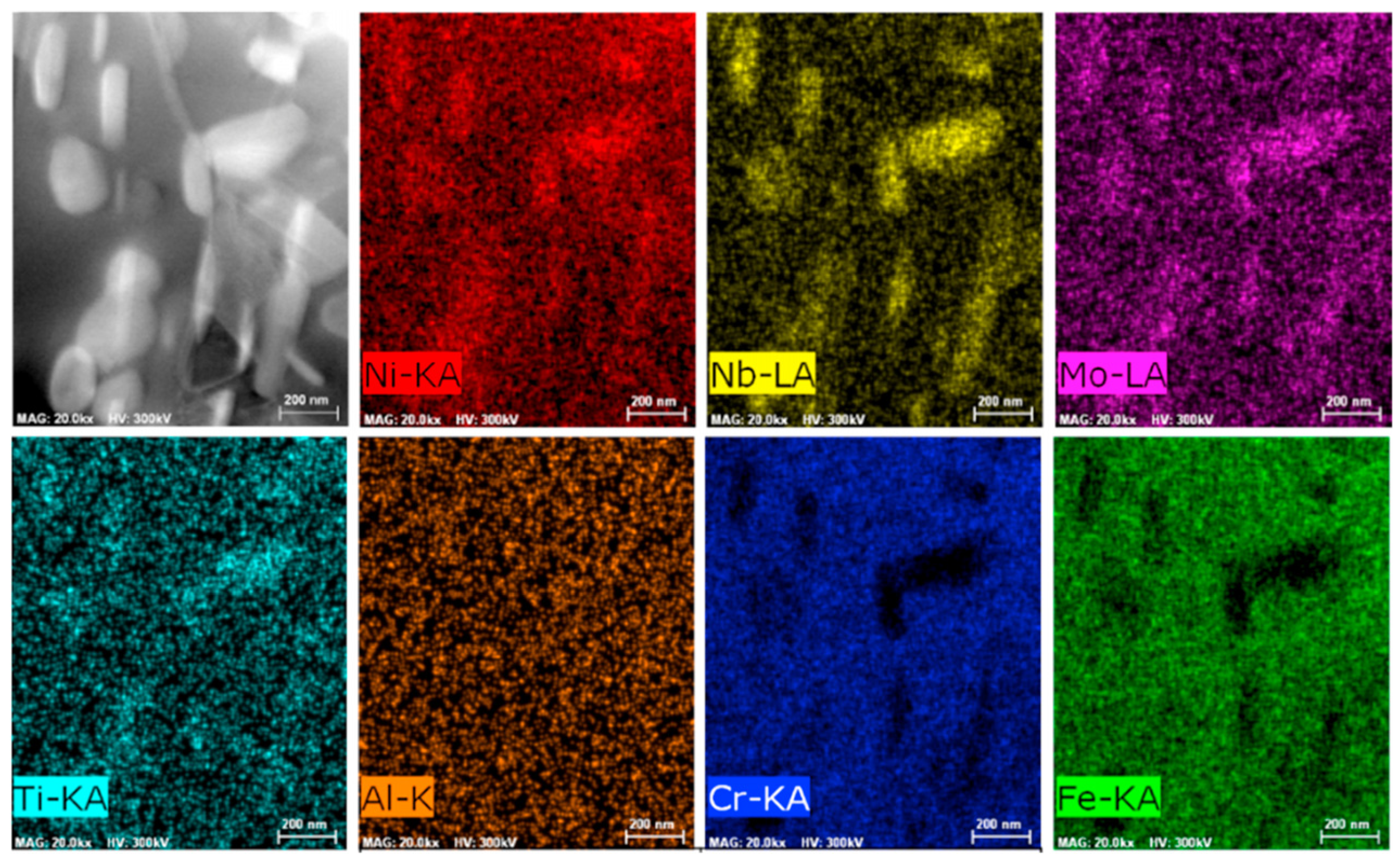




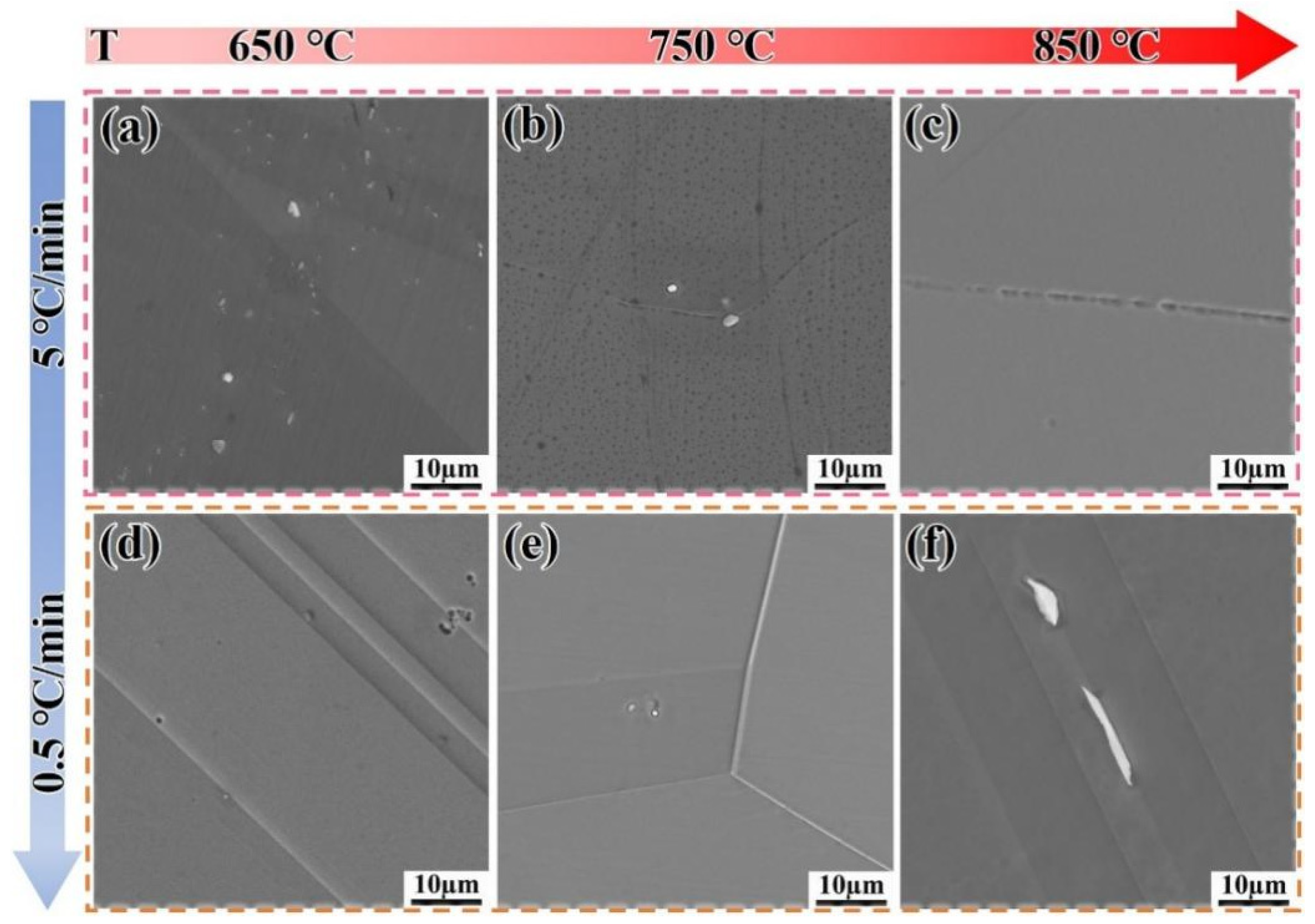



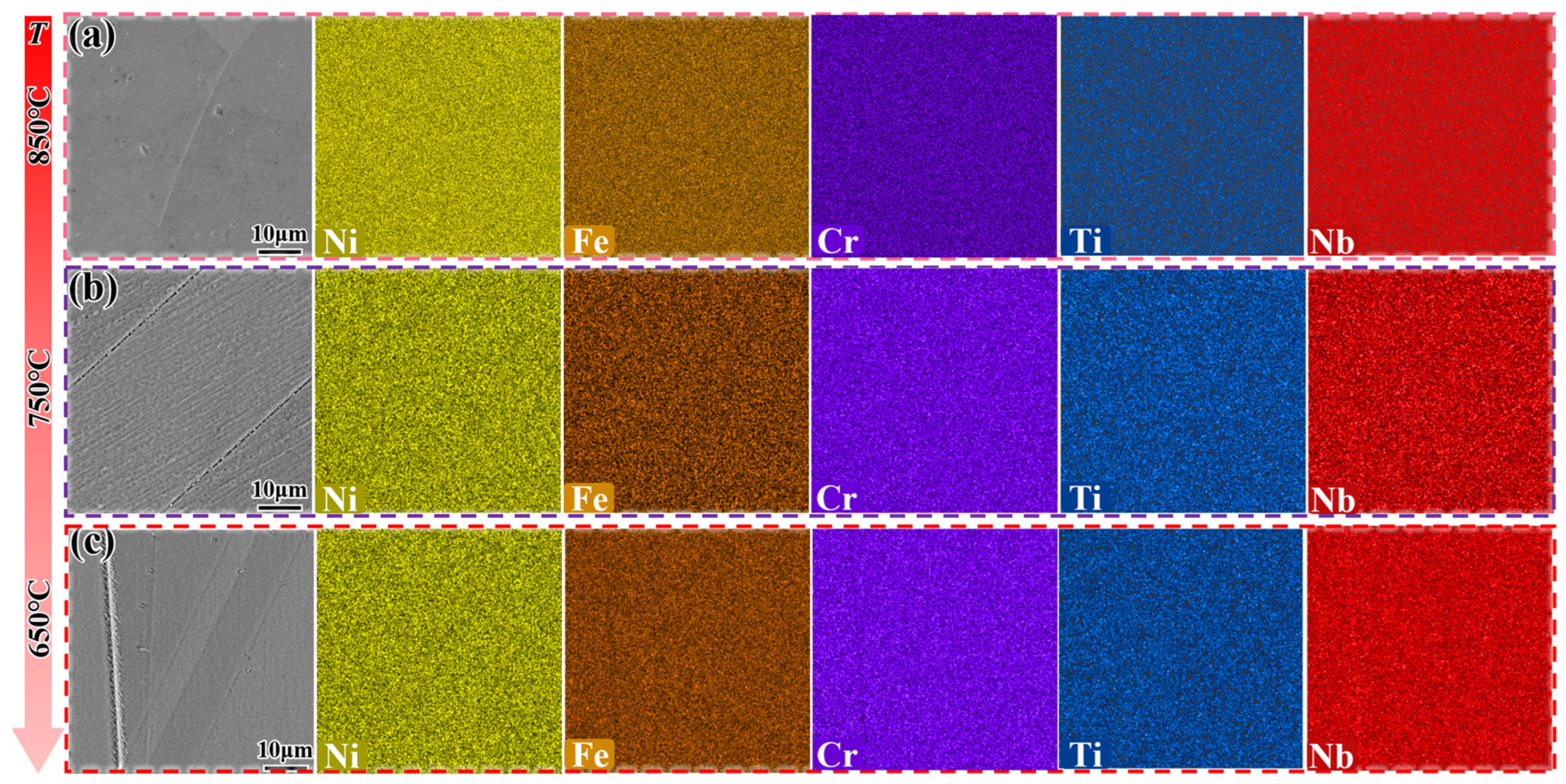

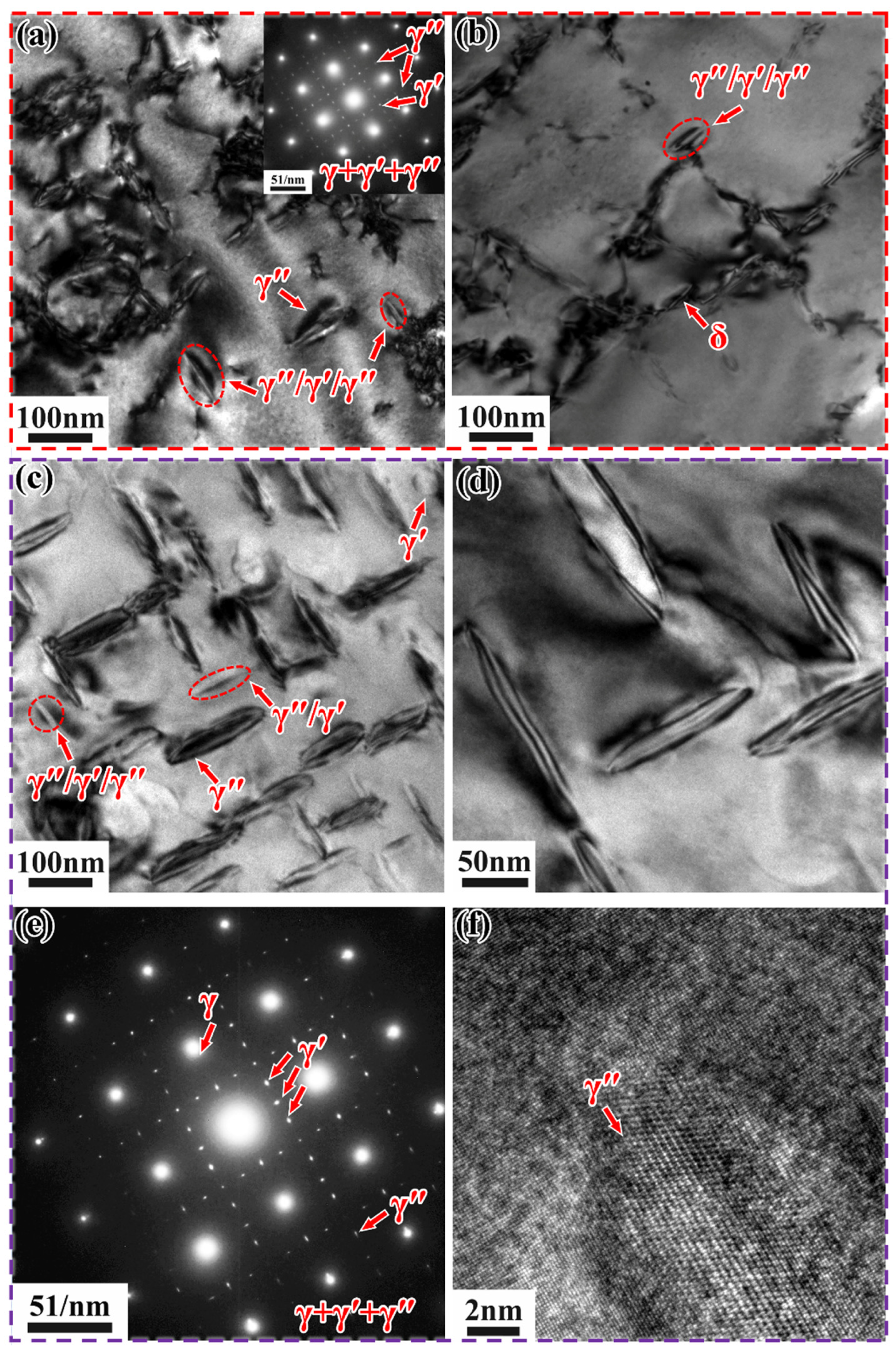
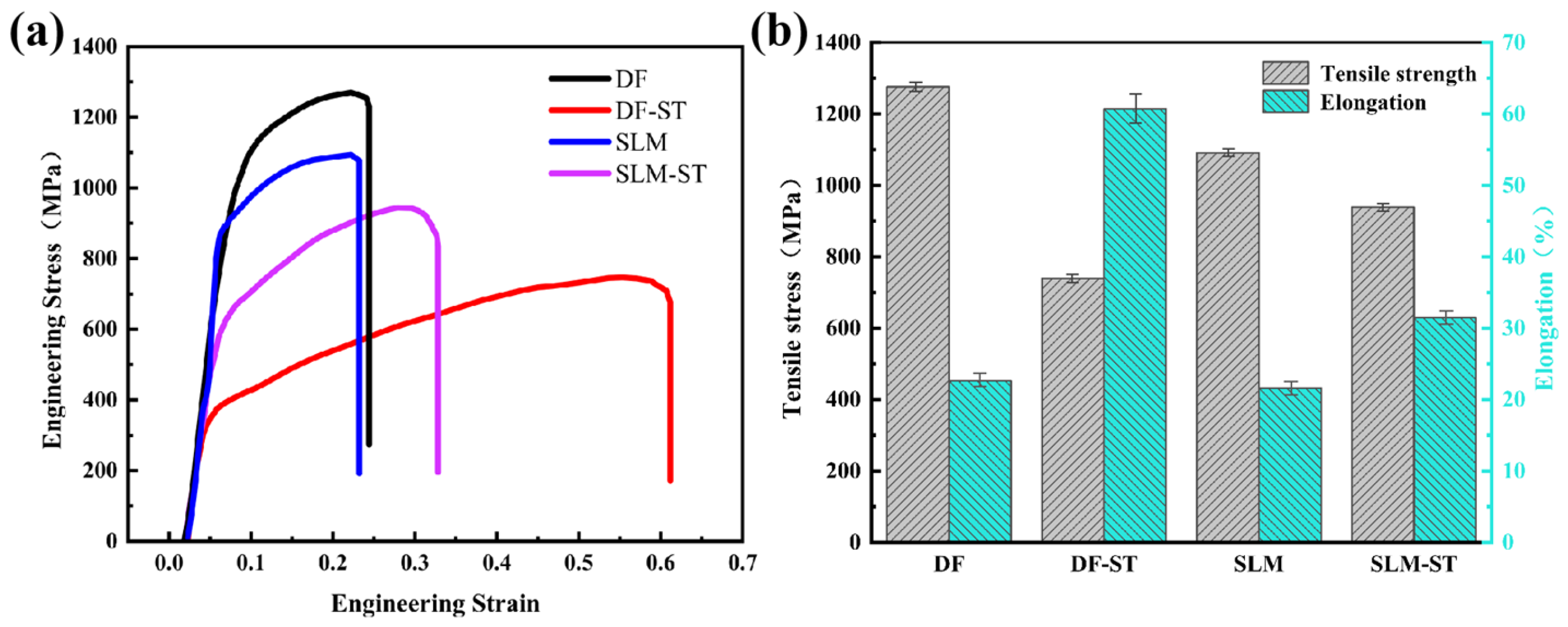
| Element | Ni | Cr | Fe | Nb | Ti | Mo | Co | Al |
|---|---|---|---|---|---|---|---|---|
| Forged | 53.89 | 17.75 | 17.27 | 5.48 | 1.01 | 2.96 | 0.27 | 0.50 |
| Additively manufactured | 53.24 | 19.41 | 15.76 | 5.48 | 0.95 | 3.26 | 0.92 | 0.42 |
| Alloy | Solidus Temperature [°C] | Liquidus Temperature [°C] | Solidification Range [°C] |
|---|---|---|---|
| DF | 1328 | 1348 | 20 |
| SLM | 1331 | 1348 | 17 |
| Temperature | Element Content [wt.%] | ||||
|---|---|---|---|---|---|
| Fe | Cr | Nb | Ti | Ni | |
| 850 °C | 16.98 | 18.08 | 4.7 | 0.93 | Bal |
| 750 °C | 16.76 | 18 | 4.99 | 0.98 | Bal |
| 650 °C | 16.65 | 17.71 | 5.07 | 0.91 | Bal |
| Materials | Tensile Strength [MPa] | Elongation [%] |
|---|---|---|
| DF | 1276 | 22.62 |
| DF-ST | 739 | 60.09 |
| SLM | 1091 | 21.62 |
| SLM-ST | 939 | 31.45 |
Disclaimer/Publisher’s Note: The statements, opinions and data contained in all publications are solely those of the individual author(s) and contributor(s) and not of MDPI and/or the editor(s). MDPI and/or the editor(s) disclaim responsibility for any injury to people or property resulting from any ideas, methods, instructions or products referred to in the content. |
© 2025 by the authors. Licensee MDPI, Basel, Switzerland. This article is an open access article distributed under the terms and conditions of the Creative Commons Attribution (CC BY) license (https://creativecommons.org/licenses/by/4.0/).
Share and Cite
Dong, Y.; Cheng, Y.; Tang, J.; Ke, Y.; Teng, J.; Jiang, F. On the Hardening and Softening Behaviors of Additively Manufactured and Forged Inconel 718 Alloys Under Non-Isothermal Heat Treatments. Materials 2025, 18, 5174. https://doi.org/10.3390/ma18225174
Dong Y, Cheng Y, Tang J, Ke Y, Teng J, Jiang F. On the Hardening and Softening Behaviors of Additively Manufactured and Forged Inconel 718 Alloys Under Non-Isothermal Heat Treatments. Materials. 2025; 18(22):5174. https://doi.org/10.3390/ma18225174
Chicago/Turabian StyleDong, Yufeng, Yetao Cheng, Jie Tang, Yubin Ke, Jie Teng, and Fulin Jiang. 2025. "On the Hardening and Softening Behaviors of Additively Manufactured and Forged Inconel 718 Alloys Under Non-Isothermal Heat Treatments" Materials 18, no. 22: 5174. https://doi.org/10.3390/ma18225174
APA StyleDong, Y., Cheng, Y., Tang, J., Ke, Y., Teng, J., & Jiang, F. (2025). On the Hardening and Softening Behaviors of Additively Manufactured and Forged Inconel 718 Alloys Under Non-Isothermal Heat Treatments. Materials, 18(22), 5174. https://doi.org/10.3390/ma18225174







